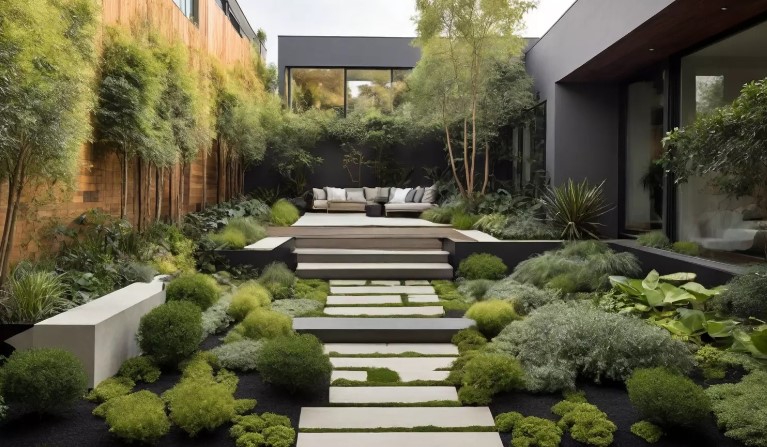
Landscape design is an artful blend of nature and culture, transforming outdoor spaces into aesthetically pleasing and functional environments. This comprehensive guide will delve into the nuances of landscape design, providing you with the knowledge and inspiration needed to create your perfect outdoor haven.
Understanding Landscape Design
What is Landscape Design?
Landscape design is the strategic planning and creation of outdoor spaces. It encompasses a wide range of elements including plants, water features, terrain, and built structures, all orchestrated to achieve harmony and beauty.
The Importance of Landscape Design
A well-designed landscape not only enhances the aesthetic appeal of a property but also increases its value. It provides a functional space for relaxation, recreation, and social gatherings, while also promoting environmental sustainability by encouraging biodiversity and reducing urban heat islands.
Core Principles of Landscape Design
Unity and Harmony
Achieving unity and harmony means ensuring all elements in the landscape work together seamlessly. This can be accomplished through consistent themes, colors, and materials.
Balance
Balance in landscape design refers to the visual equilibrium. This can be either symmetrical, where both sides mirror each other, or asymmetrical, where balance is achieved through different yet equally weighted elements.
Proportion
Proportion involves the relationship between elements in the landscape. Proper proportion ensures that no part of the landscape overwhelms the others, creating a harmonious whole.
Transition
Transition refers to the gradual change between different areas of the landscape. Smooth transitions can be achieved through the careful placement of plants, paths, and structures.
Rhythm and Line
Rhythm and line guide the eye through the landscape. This can be achieved through the repetition of elements such as plants or pathways, creating a sense of movement and flow.
Key Elements of Landscape Design
Plant Selection and Arrangement
Choosing the right plants is crucial. Consider factors such as climate, soil type, and the amount of sunlight. Group plants with similar needs together and think about how their colors, textures, and shapes will complement each other.
Hardscaping
Hardscaping includes the non-plant elements of a landscape, such as walkways, patios, walls, and pergolas. These elements provide structure and define different areas within the landscape.
Water Features
Water features like fountains, ponds, and waterfalls can add a sense of tranquility and movement to a landscape. They also support local wildlife and can help mitigate urban heat.
Lighting
Proper lighting extends the usability of a landscape into the evening hours and enhances its aesthetic appeal. Use a mix of ambient, task, and accent lighting to highlight key features and ensure safety.
Sustainable Practices
Incorporating sustainable practices is essential for an environmentally friendly landscape. This includes using native plants, implementing water-saving irrigation systems, and incorporating permeable surfaces to reduce runoff.
Steps to Designing Your Landscape
Site Analysis
Begin with a thorough analysis of your site. Note the topography, soil type, climate, and existing vegetation. Identify any issues such as poor drainage or invasive species that need to be addressed.
Developing a Plan
Create a detailed plan that includes all elements of your design. Use scale drawings to visualize how everything will fit together. Consider how different areas will be used and how they will connect.
Choosing the Right Plants
Select plants that are well-suited to your climate and soil type. Consider their mature size, growth habits, and maintenance needs. Incorporate a variety of textures, colors, and heights to create visual interest.
Implementing Hardscape Features
Install hardscape features such as pathways, patios, and walls first. These elements provide structure and define the spaces where plants will be added.
Planting
Begin with larger trees and shrubs, followed by smaller plants and groundcovers. Pay attention to spacing and arrangement to ensure plants have room to grow and thrive.
Irrigation and Lighting
Install irrigation systems to ensure your plants receive adequate water. Add lighting to enhance the beauty and functionality of your landscape after dark.
Maintenance and Upkeep
Regular Maintenance
Regular maintenance is key to keeping your landscape looking its best. This includes pruning, weeding, mulching, and monitoring for pests and diseases.
Seasonal Care
Different seasons require different care. In spring, focus on planting and preparing for the growing season. Summer requires regular watering and pest control. Fall is the time to clean up and prepare plants for winter. Winter care involves protecting plants from the cold and planning for the next season.
Sustainable Practices
Incorporate sustainable practices into your maintenance routine. Use organic fertilizers, compost, and mulch to improve soil health. Collect rainwater for irrigation and reduce waste by composting plant debris.
Conclusion
Landscape design is a rewarding endeavor that combines creativity, practicality, and environmental stewardship. By understanding the principles and elements of landscape design, and following a structured approach, you can transform any outdoor space into a beautiful and functional landscape.
